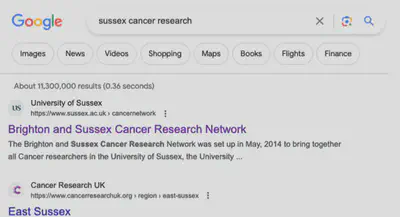Identifying the unmet need
This is a big one. At many points in this process you will need an answer for people who ask “Why do we need a centre?”. If you struggle when thinking about the answer to this, then you will struggle to get the centre off the ground. Therefore, it’s good to spend lots of time thinking about this. Your answer to this question will form the basis of many conversations, presentations, documents, and pitches to leadership as you progress.
I’ll provide examples of how I identified and demonstrated the unmet need for the Sussex Cancer Research Centre. In thinking about the unmet need for a cancer research centre in Sussex I identified three main themes:
- Lack of visibility for our cancer research.
- Missed opportunities for collaboration caused by institutional, geographic, and bureaucratic barriers.
- An unmet need in cancer patients who were not benefitting from research happening in their own community.
I wanted to ensure that I was able to evidence each of these if asked. For example, with respect to the lack of external visibility of our research, I could show that good research was happening, but that might not be apparent externally. The fact that there was incredible research already happening could be easily evidenced with grants, papers, and real-world impact. Nobody I talked to disagreed with this. No one in your institution will disagree with you if you tell them they’re doing amazing work. The lack of external visibility for this excellent research was also easy to demonstrate. I would often pull up Google, and type in “Sussex cancer research” and show people the results. I saved a screenshot and it didn’t look like we’d spoken to each other in a decade! Everyone I showed this to could imagine potential funders, potential collaborators, and potential industry partners doing the same searches going elsewhere. Something had to be done!

What exists and has existed?
You need to get a good sense of landscape and history of what you are trying to do. As an FLF it’s unlikely you will have been at your host institution long enough to know the full history in the area you are trying to establish a centre. It is worth seeking out people who have been there for a decade or more. Ask these people if anything like what you are trying to achieve has been tried before. If it has, it’s not a problem, but you do need to know. Senior people will remember previous attempts, and may not have the appetite to try again unless you can clearly state why the result will be different this time. In my situation there had been a very similar attempt, about 10 years ago, which started with a lot of motivation but soon fell into abeyance and stopped meeting. This was the Google search result above. I knew this would be a hurdle in the mind of some people that I would need to overcome. Some senior researchers I spoke to remembered an even earlier attempt but that was quickly falling out of the memory of anyone I could find.
Why will your centre be different
Previous attempts are not all bad news. It shows a continued unmet need. The motivations for previous attempts are likely still valid. So, take some time to think about why your centre might succeed where others have struggled, and how you will have a sustaining impact on the research and innovation landscape. In my case I could make a number of arguments for why this time would be different, and some of these likely apply to your institution too. I could document from grant capture, paper outputs, and recruitment numbers that we were reaching a critical mass. We were punching above our weight with some key funders and had perhaps doubled our cancer research output since previous attempts. I also noticed that key stakeholders had not been involved. We had some of the largest NHS hospitals in the country on our doorstep, but neither clinicians nor patients had been involved in previous attempts to create a cancer research centre. Funders were asking for more translational impact, including patient engagement and pathways to the clinic so this needed addressing.
Be stubborn
In addition to including new stakeholders, and having reached a critical mass, I did not shy away from the fact that I was simply too stubborn to let a centre fall into abeyance. For some reason no one challenged me when I claimed I was stubborn! Knowing that the whole endeavour fizzling out was going to be a concern of key stakeholders, particularly those involved with past attempts, meant I needed to convince others that I had the determination to make the Sussex Cancer Research Centre stick. This also meant identifying equally stubborn co-leaders, which we will discuss later.